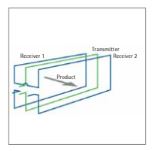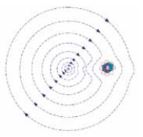Introduction
For several years, production in the food, beverage and Dairy industries has become increasingly automated. This is due to larger production volumes, increasing demands on quality and higher costs.
However, even in a well-managed, automated and mechanized food, beverage and dairy industry, contamination of end products during production cannot be completely ruled out. It’s possible that contaminants are introduced through the addition of basic ingredients delivered during the production process.
Regardless of the time and location of the contamination, there must be a key requirement that only contaminant-free products can be introduced into the market.
Foreign object detection systems, such as metal detectors or x-ray inspection systems, ensure that contaminated products can be recognized and separated so that they never leave the production facility.
Why to Use Foreign Object Detection Systems
Contaminants that find their way into food, beverages and dairy products marketed for direct consumption can cause extensive injuries. This is an area where consumer protection regulations have great significance, although the protection of a brand name is also of great importance.
A further advantage of using foreign object detection systems is the protection of machinery used in production. When a machine can no longer be used because a foreign object, such as metal, has been introduced during the production process, enormous costs can result.
These costs are often not attributed to necessary repairs of the machinery but to production downtime. Therefore, it is recommended that foreign object detection systems be used in the production process.
Metal detectors are effective, well-established and cost-effective instruments used to check for metal contamination. They ensure that products remain largely free of metal contamination.
On the other hand, contaminants, such as stones, glass, ceramics, bones, plastics and, of course, metal, can be recognized and discharged with an x-ray inspection system.
Metal Detectors
The bar is constantly being raised in the area of process security in industry. Manufacturers are required to establish inspection points in production at which products can be tested for foreign objects.
According to diverse quality and safety standards, such as the new FSMA, metal detectors are no longer an
option but a requirement.
The requirement of transparency and traceability is mainly directed at retail sales. However, the responsibility rests with all previous levels of the food production chain, including raw material manufacturers, food producers and transport companies.
Modern metal detectors do much more than just find metal particles. They are configured and expanded on-site into quality control instruments.
Nowadays, it goes without saying that they provide production data, such as piece counts, number of metal detections and times of occurrence, detailed error messages, recording start times, detection sensitivity settings, as well as other information.
Advantages of using metal detectors
- Transparency
- Consumer confidence
- Minimizing food risks
- Effective control of internal processes and
- minimizing risk of downtime
Design of Metal Detectors
In order to conform to all hygienic requirements, especially in wet areas, the housing of the metal detector is made of stainless steel. The evaluating electronics are located either directly within the head of the detector or in a control unit located a few meters from the detector.
The actual measuring system is located within the head of the detector and consists of three coils The middle coil is the transmitter. It transmits a high frequency alternating field. Two receiver coils are located at equal distance on either side of the transmitter.
The two receiver coils are electrically connected in such a way that voltage induced by the transmitter cancels itself out. The resting voltage of the receiver is equal to zero and changes if metal parts are introduced to the head of the detector.

transmitter and receiver coils
The corresponding signal is then amplified and electronically processed so that it results in an alert, indicating that metal has been detected. The size of the aperture in a metal detector can be selected based on the product being tested because the
smaller the aperture is, the higher the level of basic sensitivity that can be achieved.
Effects of Various Types of Metal on the Magnetic Field
In general, one can differentiate between two effects of metal on the magnetic
field:
– Magnetic field focusing
– Magnetic field displacement
Magnetic Field Focusing
All ferromagnetic metals (iron) and ferrites cause the lines of a magnetic field to be focused

This effect is considered reactive and, depending on the permeability level, it can be observed at different intensities.
However, it is always stronger than the effect of magnetic field displacement, . At the point when the metal is within the search channel, a localized focusing of the magnetic field lines occurs.
This inhomogeneity of the field of transmission leads to varying induction voltages on both receiver coils and results in a metal signal that can be evaluated.
Magnetic Field Displacement
With diamagnetic and paramagnetic metals (stainless steel and non-ferrous metals) magnetic field focusing does not occur on account of the permeability.
Due to the alternating field of the transmitter, a voltage is induced into these metals. Depending on the electrical conductivity, a current results; this is also referred to as “eddy current formation,” which, in turn, creates its own magnetic field.
The magnetic field generated within the metal particle is opposed to the exciting field in accordance with “Lenz’s Rule.” Both fields repel one another and magnetic field displacement results in the range of the metal particle . As can be understood from the below image.

The inhomogeneity of the receiver field caused by this process leads to measuring voltage at the receiver coils, which is evaluated as a metal signal.
Testing the Metal Detector
The Product Effect
When the product being tested is electrically or magnetically conductive, we refer to this as the product effect. From a metal detection standpoint, the conductive product reacts like stainless steel or non-ferrous metal in this case.
Because of the much larger volume of the product in comparison to a possible metal contaminant, it is easy to
assume that the signal vector of the conductive product can be larger than the metal vector.
In order to recognize and indicate a metal part when faced with this type of constellation, modern metal detectors are capable of tuning out the product effect.
Sensitivity within the Aperture
The sensitivity of a metal detector within the tunnel-shaped aperture is not constant.
The reason for this has to do with the field distribution within the aperture. The sensitivity is reduced as it is distanced from the transmitter/receiver. As a result, the least sensitive point is found in the center of the aperture as below show in fig.

Test Items for Metal Detectors
The signal recognized by the metal detector is always composed of the metal signal and the product signal. Therefore, for a product that demonstrates product effect, it is important that the sensitivity test is performed with a prepared original product.
In the process, the test item should not be placed on or under the product but should be within packaging. If the responsiveness of the metal detector is to be tested using various types of metal, you must prepare various products with test items. As a rule, test items should be chosen so that the signal of the test item is larger than the responsiveness setting of the metal detector.
For operational security reasons, the responsiveness thresh- old should lie clearly above the product signal. The sensitivity to be achieved with the original product is called the operational sensitivity.
The term basic sensitivity, by contrast, describes the detection sensitivity of the device.
When testing metal detectors, you should always introduce the metal item through the center of the detector coil opening to simulate the least advantageous case scenario.
Metal-Free Zone
The stainless steel housing of the metal detector ensures that the largest portion of the magnetic field lines remains within the housing. Nevertheless, a few magnetic field lines will escape the aperture and close within the environment surrounding the metal detector.
This effect can be minimized through special housing measures, but it can never be completely avoided. Detector coils with a reduced metal-free zone are state-of-the-art today. Of course, field lines that escape outward can also be influenced outside the metal detector. Therefore, metal detectors usually have a zone
that does not contain any metal directly in front of the aperture.
Separation of Detected Metal Objects
Detecting a metal object is one action, removing it is another. However, this action is just as important. There are a variety of system solutions involving metal detection and object separation, depending on the type of product and how it is dispensed.
Metal Detection in Aluminum Packaging
Detection of metal objects in aluminum packaging is especially difficult using a conventional metal detector. With metal detectors that operate according to the principle of magnetic field measurement technology, it is possible to detect magnetized iron and stainless steel contaminants in massive aluminum packages.
The product effect of the product being examined has no influence on the detection accuracy, in contrast to inductive metal detectors.
The functional principle is simple and effective. The residual magnetism of a magnetized metal particle is detected. Therefore, not the size of an object but the magnetic remanence (residual magnetism) of metals is used for detection purposes.
Theoretically, only ferromagnetic substances, such as iron, have this quality. Non- ferrous metals (such as aluminum, copper, brass, bronze, etc.) are not ferromagnetic and cannot be detected by metal detectors that operate according to the principle of magnetic field measurement technology.
Ideally, alloyed stainless steel (e.g., AISI 304 = DIN 1.4301, AISI 316 = 1.4401) is austenitic and therefore, not magnetizable. This means that an ideal, austenitic stainless steel cannot be detected. However, ideal stainless steel does not exist in production environments.
As a rule, stainless steel in production environments contains ferritic zones in its molecular structure as a result of deformation and abrasion. This makes the stainless steel detectable.